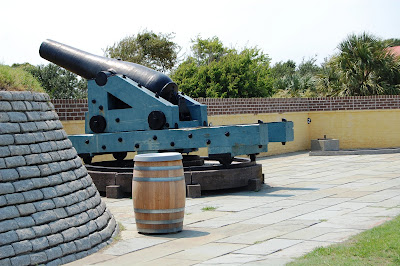The first fort we toured was Fort Sumter just east of Charleston. The boat ride to the island was 30 minutes long and the tour guide gave us a LOT of information on the way over, most of which I don't remember. However, I do know the most important thing, and that is that Fort Sumter is where the first official shots of the Civil War took place. Although it is a very important fort from history, this fort was both mine and Tyler's and least favorite. The fort is in ruins now, and other than a few old cannons that sit on the grounds, that is all that's there. Still, I'm glad we went because it was good to hear the history of the beginning of the war that changed America forever.
 This is actually the back wall of Fort Sumter. The original entrance to the fort did not face Charleston.
This is actually the back wall of Fort Sumter. The original entrance to the fort did not face Charleston. All the different flags that have been raised over Fort Sumter in the past.
All the different flags that have been raised over Fort Sumter in the past. A cannon shell stuck in the wall at Fort Sumter; left from the Civil War.
A cannon shell stuck in the wall at Fort Sumter; left from the Civil War. Tyler and I in front of the Fort Sumter ruins.
Tyler and I in front of the Fort Sumter ruins.The second fort we went to was Fort Moultrie, which is in Mount Pleasant/Sullivan's Island, just north of the Charleston peninsula. This fort was Tyler's favorite. Fort Moultrie was one of the forts controlled by the Confederate Army that started firing on Fort Sumter at the beginning of the Civil War. However, it was first built to defend Charleston during the Revolutionary War.
The South Carolina state flag (with the Palmetto tree and crescent moon pictured above) originated at Fort Moultrie. During the Revolutionary War British ships began firing on Fort Moultrie before it was completed, but the wall facing the Atlantic ocean consisted of Palmetto trunks and sand dunes. The Palmetto tree trunk is somewhat spongy and that, combined with sand, made for a pretty shock absorbent wall- in fact, the British cannon balls just bounced off the Palmetto trunks.
Fort Moultrie also played an important role in WWII. They still have several bunkers filled with memorabilia from the 1940's and the rooms look like a picture right out of Pearl Harbor or something. The cool thing about Fort Moultrie is that it is very well preserved, and they now have the fort divided into sections representing its role in each of the wars it played a part. The earliest part of the fort, representing the Revolutionary War era, is still in tact and still painted a bright yellow, just the way it was then.
 Fort Moultrie- you can kind of see the different sections of the fort here. All the grassy knolls are covering an underground maze of magazines and bunkers.
Fort Moultrie- you can kind of see the different sections of the fort here. All the grassy knolls are covering an underground maze of magazines and bunkers. Entering the yellow-brick section of the fort. This is the oldest part built for the Revolutionary War. Unfortunately, the Palmetto and sand walls are gone.
Entering the yellow-brick section of the fort. This is the oldest part built for the Revolutionary War. Unfortunately, the Palmetto and sand walls are gone.The last fort Tyler and I visited was Fort Pulaski on Tybee Island, just outside of Savannah. This was my favorite fort because it was the most picturesque of the three (forts really aren't that pretty) and because it was so impenetrable (or so it seemed). Fort Pulaski was built kind of like a medieval castle- complete with a gator filled moat surrounding it and a drawbridge. There were so many different things, like cannon positioning, 11 feet thick brick walls, and the intricate underground foundation for the fort that was sunk 70 feet into the mud, that were supposed to make the fort impenetrable to the Union forces building batteries on the other side of the Savannah River. Unfortunately, new artillery, the rifled cannon, destroyed the brick wall facing the Union soldiers and Fort Pulaski surrendered, having not really done much. The fort is very well preserved though, and still very pretty and interesting.
 The outside wall of the fort and moat. The wall is still riddled with cannon shells, and the part of the wall that was completely destroyed by Union forces was rebuilt only about 6 weeks after the assault. The bright red bricks were the replacement bricks.
The outside wall of the fort and moat. The wall is still riddled with cannon shells, and the part of the wall that was completely destroyed by Union forces was rebuilt only about 6 weeks after the assault. The bright red bricks were the replacement bricks. If you look closely you can see the Cockspur Lighthouse barely visible in the distance. The Union batteries were directly across from Fort Pulaski on the other side of the Savannah River and the lighthouse. The small lighthouse was standing there during the war, but was never hit by cannons and sustained zero damages. Kind of cool.
If you look closely you can see the Cockspur Lighthouse barely visible in the distance. The Union batteries were directly across from Fort Pulaski on the other side of the Savannah River and the lighthouse. The small lighthouse was standing there during the war, but was never hit by cannons and sustained zero damages. Kind of cool.







No comments:
Post a Comment